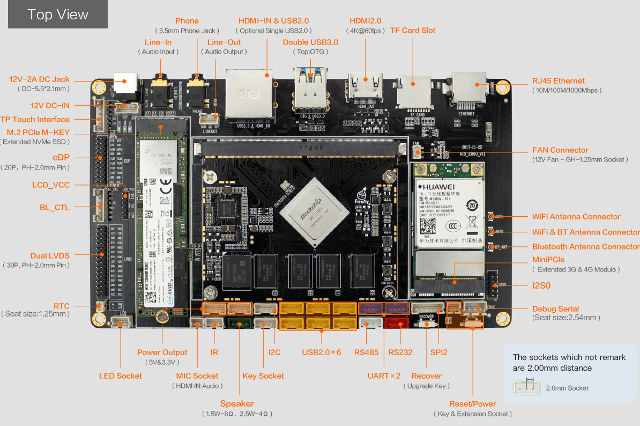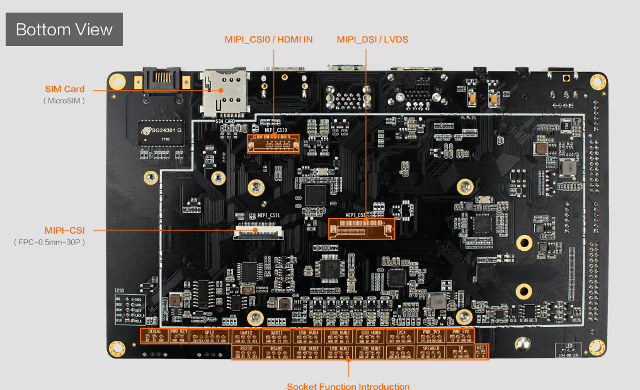Firefly-RK3399 was the very first Rockchip RK3399 development board when it launched in late 2016, and it mostly stayed that way until others joined in late 2017, early 2018 with products like Orange Pi RK3399, ODROID-N1, Rock960, or Pine64 RockPro64 among others.
Firefly team has now unveiled another higher end “all-in-board industrial board” with their Firefly AIO-3399J board featuring their RK3399 CoreBoard module, and a baseboard exposing plenty of I/O and connector, including support for M.2 drives, and 4G LTE mini PCIe cards.

Firefly AIO-3399J specifications:
- SoM – RK3399 CoreBoard:
- SoC – Rockchip RK3399 hexa-core big.LITTLE processor with dual core ARM Cortex A72 up to 2.0 GHz and quad core Cortex A53 processor, ARM Mali-T860 MP4 GPU with OpenGL 1.1 to 3.1 support, OpenVG1.1, OpenCL and DX 11 support
- System Memory – 2GB or 4GB DDR3-1333
- Storage – 16GB eMMC 5.1 flash (other capacities also available on demand up to 128GB)
- RK808 PMU
- 8-layer PCB
- Baseboard:
- Storage – M.2 M-Key slot working with NVMe SSD, micro SD card slot
- Video & Display Interfaces
- 1x HDMI 2.0 output up to 4K @ 60 Hz with HDCP 1.4/2.2
- Optional 1x HDMI input up to 1080p60
- 1x eDP 1.3 (4-lanes @ 10.8 Gbps)
- Dual channel MIPI DSI interface up to 2560×1600 @ 60 Hz
- Dual channel 24-bit LVDS up to 1920×1200 @ 60 Hz
- Video Decode – 4K VP9 and 10-bit H.265 video codec support up to 60 fps
- Audio
- HDMI audio output
- MIC audio input
- Analog audio via 3.5mm combo jack with stereo for output and input
- S/PDIF output interface
- 1x LINE in via 3.5mm jack, 1x LINE out via header
- Dual speaker support (8Ω/1.6W or 4Ω/2.7W)
- I2S output and input interface up to 8 channels
- Connectivity
- Gigabit Ethernet port using RTL8211E transceiver
- WiFi 802.11ac 2×2 MIMO and Bluetooth 4.1
- Optional 3G/4G LTE mini PCIe module
- USB – 1x USB 2.0 host port, 2x USB 3.0 port, 6x USB 2.0 headers
- Camera
- 2x MIPI CSI interfaces up to 13MP or 2x 8MP
- 1x DVP camera interface up to 5MP
- Serial – 1x RS232, 2x TTL serial, 1x RS485
- Debugging – 3-pin serial header
- Expansion
- 1x mini PCIe for 3G/ 4G LTE card
- 1x M.2 M-key
- 1x SIM card slot
- Headers exposing SPI, I2C, ADC, GPIO, keys, power inputs and outputs
- Misc – IR receiver, RTC with battery socket, reset & recovery keys,
- Power Supply – 12V/2A DC
- Dimensions – 182.8 x 107.1 mm (4-layer PCB)

The board supports Android 7.1, Android 6.0,Ubuntu 16.04, and u-boot, and comes with an “open source SDK and related materials”, all of which you can find via the product page.
Firefly AIO-3399J board can be purchased now for $165 with 2G RAM/16GB flash or $235 with 4GB RAM/16GB flash directly on Firefly Shop. Note the boards currently sold do not come with HDMI input.

Jean-Luc started CNX Software in 2010 as a part-time endeavor, before quitting his job as a software engineering manager, and starting to write daily news, and reviews full time later in 2011.
Support CNX Software! Donate via cryptocurrencies, become a Patron on Patreon, or purchase goods on Amazon or Aliexpress




